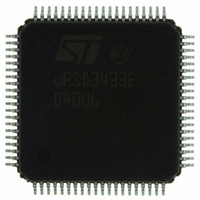UPSD3433EB40U6 STMicroelectronics, UPSD3433EB40U6 Datasheet - Page 52

UPSD3433EB40U6
Manufacturer Part Number
UPSD3433EB40U6
Description
MCU 8BIT 8032 128KB FLASH 80TQFP
Manufacturer
STMicroelectronics
Series
µPSDr
Datasheet
1.UPSD3434EB40T6.pdf
(293 pages)
Specifications of UPSD3433EB40U6
Core Processor
8032
Core Size
8-Bit
Speed
40MHz
Connectivity
I²C, IrDA, SPI, UART/USART, USB
Peripherals
LVD, POR, PWM, WDT
Number Of I /o
46
Program Memory Size
160KB (160K x 8)
Program Memory Type
FLASH
Ram Size
8K x 8
Voltage - Supply (vcc/vdd)
3 V ~ 5.5 V
Data Converters
A/D 8x10b
Oscillator Type
Internal
Operating Temperature
-40°C ~ 85°C
Package / Case
80-TQFP, 80-VQFP
For Use With
497-5518 - EVAL BOARD RFID READER497-5046 - KIT TOOL FOR ST7/UPSD/STR7 MCU
Lead Free Status / RoHS Status
Lead free / RoHS Compliant
Eeprom Size
-
Other names
497-5660
Available stocks
Company
Part Number
Manufacturer
Quantity
Price
Company:
Part Number:
UPSD3433EB40U6
Manufacturer:
STMicroelectronics
Quantity:
10 000
- Current page: 52 of 293
- Download datasheet (5Mb)
Interrupt system
13
Note:
52/293
Interrupt system
The uPSD34xx has an 12-source, two priority level interrupt structure summarized in
Table
Firmware may assign each interrupt source either high or low priority by writing to bits in the
SFRs named, IP and IPA, shown in
interrupt of equal or higher priority is not already being serviced. If an interrupt of equal or
higher priority is being serviced, the new interrupt will wait until it is finished before being
serviced. If a lower priority interrupt is being serviced, it will be stopped and the new
interrupt is serviced. When the new interrupt is finished, the lower priority interrupt that was
stopped will be completed. If new interrupt requests are of the same priority level and are
received simultaneously, an internal polling sequence determines which request is selected
for service. Thus, within each of the two priority levels, there is a second priority structure
determined by the polling sequence.
Firmware may individually enable or disable interrupt sources by writing to bits in the SFRs
named, IE and IEA, shown in
disable bit (EA), which can be cleared to disable all 12 interrupts at once, as shown in
Table 17 on page
enabling process.
Each interrupt source has at least one interrupt flag that indicates whether or not an
interrupt is pending. These flags reside in bits of various SFRs shown in
page
All of the interrupt flags are latched into the interrupt control system at the beginning of each
MCU machine cycle, and they are polled at the beginning of the following machine cycle. If
polling determines one of the flags was set, the interrupt control system automatically
generates an LCALL to the user’s Interrupt Service Routine (ISR) firmware stored in
program memory at the appropriate vector address.
●
●
●
●
●
Interrupt flags are polled based on a sample taken in the previous MCU machine cycle. If an
interrupt flag is active in one cycle but is denied serviced due to the conditions above, and
then later it is not active when the conditions above are finally satisfied, the previously
denied interrupt will not be serviced. This means that active interrupts are not remembered.
Every poling cycle is new.
Assuming all of the listed conditions are satisfied, the MCU executes the hardware
generated LCALL to the appropriate ISR. This LCALL pushes the contents of the PC onto
the stack (but it does not save the PSW) and loads the PC with the appropriate interrupt
vector address. Program execution then jumps to the ISR at the vector address.
Execution precedes in the ISR. It may be necessary for the ISR firmware to clear the
pending interrupt flag for some interrupt sources, because not all interrupt flags are
automatically cleared by hardware when the ISR is called, as shown in
The specific vector address for each of the interrupt sources are listed in
page
An interrupt of equal or higher priority is already in progress
The current machine cycle is not the final cycle in the execution of the instruction in
progress
The current instruction involves a write to any of the SFRs: IE, IEA, IP, or IPA
The current instruction is an RETI
53.
16.
53. However, this LCALL jump may be blocked by any of the following conditions:
56.
Figure 13 on page 54
Table 16 on page
Table
16. An interrupt will be serviced as long as an
illustrates the interrupt priority, polling, and
53. The SFR named IE contains a global
Table 16 on page
Table 16 on
Table 16 on
uPSD34xx
53.
Related parts for UPSD3433EB40U6
Image
Part Number
Description
Manufacturer
Datasheet
Request
R

Part Number:
Description:
MCU 8BIT 8032 128KB FLASH 80TQFP
Manufacturer:
STMicroelectronics
Datasheet:

Part Number:
Description:
MCU 8BIT 8032 128KB FLASH 52TQFP
Manufacturer:
STMicroelectronics
Datasheet:

Part Number:
Description:
STMicroelectronics [RIPPLE-CARRY BINARY COUNTER/DIVIDERS]
Manufacturer:
STMicroelectronics
Datasheet:

Part Number:
Description:
STMicroelectronics [LIQUID-CRYSTAL DISPLAY DRIVERS]
Manufacturer:
STMicroelectronics
Datasheet:

Part Number:
Description:
BOARD EVAL FOR MEMS SENSORS
Manufacturer:
STMicroelectronics
Datasheet:

Part Number:
Description:
NPN TRANSISTOR POWER MODULE
Manufacturer:
STMicroelectronics
Datasheet:

Part Number:
Description:
TURBOSWITCH ULTRA-FAST HIGH VOLTAGE DIODE
Manufacturer:
STMicroelectronics
Datasheet:

Part Number:
Description:
Manufacturer:
STMicroelectronics
Datasheet:

Part Number:
Description:
DIODE / SCR MODULE
Manufacturer:
STMicroelectronics
Datasheet:

Part Number:
Description:
DIODE / SCR MODULE
Manufacturer:
STMicroelectronics
Datasheet:

Part Number:
Description:
Search -----> STE16N100
Manufacturer:
STMicroelectronics
Datasheet:

Part Number:
Description:
Search ---> STE53NA50
Manufacturer:
STMicroelectronics
Datasheet:











